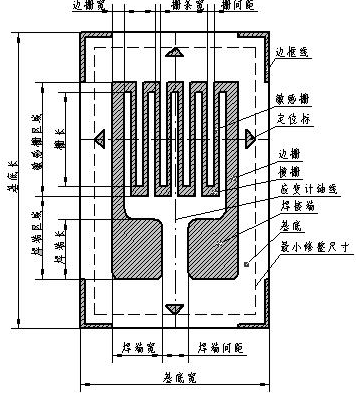Strain Gauge Terminology And Introduction For Strain Gauge Materials
- The main structure of the resistance strain gauge and the names of each part are shown in the figure:

II.Material of resistance strain gauge
(1) Sensitive grid material
The sensitive grid of the resistance strain gauge is made of alloy material. The sensitive grid realizes the strain resistance conversion in the strain gauge, which is the main part that determines the working characteristics of the strain gauge. Our company mainly uses constantan foil, karma foil, and annealed constantan foil.
|
Name |
Main ingredients |
Features and uses |
|
Constantan |
Copper, nickel |
Have excellent comprehensive performance and low cost. Can be made into a temperature self-compensation type, and are the most widely used, but they cannot work at higher temperatures. |
|
Annealed Constantan |
Copper, nickel |
Flexible, high elongation, deformation up to 20%, no temperature self-compensation capability, poor fatigue life, used for large strain measurement. |
|
Karma |
Nickel, chromium, aluminum, iron |
Good stability, high resistivity, sensitivity coefficient and fatigue life, can be made into temperature self-compensation type or elastic film self-compensation type. The heat output curve is flatter than Constantan, and the temperature self-compensation effect is better. It can be statically measured in the range of -269~+290℃, and the short-term high temperature can reach 400℃. |
(2) Base material
(a) Paper
The paper used for making resistance strain gauges is generally cotton paper, copy paper, cigarette paper or degreased capacitor paper with a thickness of less than 0.06mm.
(b) Film
At present, the glue film commonly used in the manufacture of strain gauges is made of organic resins with different compositions. Their thickness is about 0.02 to 0.04 mm. The film materials commonly used by our company include modified phenolic resin, polyimide resin, epoxy resin, epoxy-phenolic resin and so on. They can be used for both the base material and the binder material.
If glass fiber or other fiber materials are added to the organic resin, the elastic modulus and mechanical strength of the film can be increased; creep can be reduced; fatigue life can be increased; the measuring strain range can be increased; the temperature resistance range of the material can be increased.
(c) Dipped glass fiber cloth
Fiberglass cloth is a material with good moisture resistance, heat resistance and electrical insulation, high mechanical strength and soft texture. The impregnated glass fiber cloth is made of alkali-free glass fiber cloth with a thickness of not more than 0.025mm, and the adhesive is uniformly coated on it and cured, and its thickness is about 0.04-0.05mm. This base material is suitable for manufacturing low temperature, medium temperature and high temperature strain gauges.
